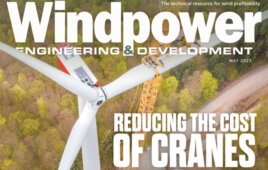01 Editorial:
What if the nation went wild for wind power?
44 Projects:
Decommissioning Canada’s oldest wind farm
66 Cover
Foundations that float
What if the nation went wild for wind power?
By: Paul Dvorak
Suppose our nation decided that as coal and nuclear-powered facilities reached the end of their useful life, they would be replaced by wind-generated power. How many turbines would it take to generate that power and how much land would they occupy? Credit for the idea must go to Jeff Grybowski, CEO of Deepwater Wind, who suggested the goal at the recent AWEA Offshore Wind conference.
To start, sources put U.S. power use at about 4.986 x 109 megawatt-hours in 2013. Let’s round up to 5 x 109 MWh. The EIA says those sources plus petroleum produced 54% of the nation’s power. That means our wind project must eventually replace:
P = 5 x 109 MWh x 0.54
= 2.7 x 109 MWh.
This experiment does not remove natural gas from the mix. Natural gas generators cycle quickly up and down, and would be needed to accommodate the variable nature of wind power.
Let’s think big and use turbines rated at 5 MW and a capacity factor of 35%. (The consulting firm Make Consulting recently commented that some capacity factors in North America are getting close to 50%.)
Therefore, for a full year, one 5-MW turbine would produce:
Pturbine-year = 5 MW x 365 days x 24 hr/day x 0.35
(the capacity factor)
= 15,330 MWh/year
To find the number of turbines needed:
N = (2.7 x 109 MWh/year) / 15.33 x 103 MWh/ year-turbine
= 176,125 turbines, the number needed to replace the retired coal and nuclear power plants.
To space the turbines, draw a tic-tac-toe grid, assume one mile on a side, and place a turbine in the center of each square. In this scheme, one square mile can fit nine turbines or 0.11 mi2/turbine.
For the total land area to accommodate 176,125 turbines, use:
Atotal = 176,125 turbines x 0.11 mi2/turbine
= 19,374 mi2
An online list of state sizes (http://tinyurl.com/statesize) tells that West Virginia has about 24,078 mi2, enough for one massive wind farm that would keep some of the state’s former coal miners off unemployment rolls. Or, to build a North American energy powerhouse, flat and windy North Dakota (68,976 mi2) has enough land for three such wind farms and the proximity to generate power for all of Canada as well.
Costs can be brought down by standardizing on one turbine size that several manufacturers can produce. The same would happen on the construction side if, for example, a 120-m tower was the standard.
 What about costs? Recent reports are that a wind farm in Iowa constructed by an experienced team cost about $1.7 million/MW. Hence:
What about costs? Recent reports are that a wind farm in Iowa constructed by an experienced team cost about $1.7 million/MW. Hence:
Cost total = 176,125 turbines x 5 MW/turbine x $1.7 million/MW
= $1,497,063 million ~ $1.5 trillion
Spreading the project over 30 years would call for a private investment of $49.9 billion per year. Of course, transmission is the fly in this ointment so portions of the project would have to be built at several sites in each state. Does that sound doable? It’s just a thought.
Filed Under: Digital issues




